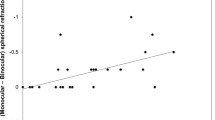Abstract
A 1-year clinical trial to determine the prevalence of general dysfunctions in binocular vision in a nonpresbyopic population was conducted in 1679 subjects aged 18 to 38 years. A thorough eye examination included binocular vision testing. A high prevalence of binocular vision dysfunctions was found. Of the subjects, 56.2% presented symptoms of binocular dysfunctions, 61.4% with accommodation disorders and 38.6% vergence disorders. Accommodation insufficiency was most prevalent among those with symptoms (11.4%).
Similar content being viewed by others
References
Hokoda SC. General binocular dysfunctions in an urban optometry clinic. J Am Optom Assoc. 1985;56:560–562.
Purcell LR, Nuffer JS, Clements SD, et al. The cost effectiveness of selected optometric procedures. J Am Optom Assoc. 1983;54:643–647.
Bennett GR, Blondin M, Ruskiewicz J. Incidence and prevalence of selected visual conditions. J Am Optom Assoc. 1982;53:647–656.
Griffin JR. Binocular Anomalies: Procedures for Vision Therapy. 2nd ed. Chicago, Ill: Professional Press; 1982: chap 1.
Grisham D. The dynamics of fusional vergence eye movement in binocular dysfunction. Am J Optom Physiol Opt. 1980;57:645–655.
Hoffman L, Cohen AH, Feuer G. Effectiveness of non-strabismus optometric vision training in a private practice. Am J Optom Arch Am Acad Optom. 1973;50:813–816.
Pickwel LD. Binocular Vision Anomalies: Investigation and Treatment. 2nd ed. London, England: Butterworth; 1989.
Regan D. Binocular vision. In: Regan D, ed. Vision and Visual Dysfunction. London, England: MacMillan Press; 1991:46–70.
Daum KM. Accommodative dysfunctions. Doc Ophthalmol. 1983; 55:177–198.
Daum KM. Characteristics of exodeviations: II. Changes with treatment with orthoptics. Am J Optom Physiol Opt. 1986;63:244–251.
Benjamin, WJ. Fusion and binocularity. 1st ed. In: Clinical Refraction. Philadelphia, Pa: WB Saunders Co; 1998:255–278.
Grosvenor T. Anomalies of refraction and binocular vision. In: Grosvenor T, ed. Primary Care Optometry. 3rd ed. Washington, DC: Butterworth-Heinemann; 1996.
Scheiman M, Wick B. Clinical Management of Binocular Vision: Heterophoric Accommodative, and Eye Movement Disorders. Philadelphia, Pa: JB Lippincott Co; 1994:3–31.
Author information
Authors and Affiliations
Rights and permissions
About this article
Cite this article
Montés-Micó, R. Prevalence of general dysfunctions in binocular vision. Ann Ophthalmol 33, 205–208 (2001). https://doi.org/10.1007/s12009-001-0027-8
Issue Date:
DOI: https://doi.org/10.1007/s12009-001-0027-8




